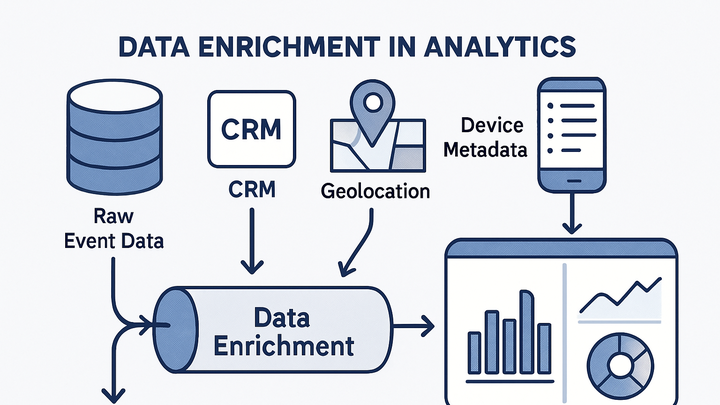Published on 2025-06-22T02:46:32Z
What is Data Enrichment? Examples in Analytics
Data enrichment is the process of augmenting raw analytics data with additional context from external or internal sources.
In the analytics industry, this means appending attributes like demographics, firmographics, geolocation, device metadata, and CRM records to event-level data.
By integrating these details, organizations can transform basic pageviews or interactions into rich, actionable insights that drive segmentation, personalization, and predictive modeling.
Data enrichment can be performed in real-time—enabling instant personalization on websites or applications—or in batch mode, supporting in-depth reporting and machine learning workflows.
Tools like PlainSignal provide cookie-free enrichment at the edge, adding metadata without compromising privacy, while platforms like Google Analytics 4 leverage Google Signals and user-defined properties to enrich sessions when users opt in.
Effective data enrichment requires careful attention to data quality, privacy compliance, and performance to ensure that augmented datasets remain accurate, reliable, and actionable.
Data enrichment
Data enrichment enhances analytics data by adding context from external or internal sources, improving insights, personalization, and accuracy.
Why Data Enrichment Matters in Analytics
Data enrichment transforms basic analytics data into deeper insights by adding relevant context. It improves the accuracy and usability of raw events, enabling more informed decision-making across marketing, product, and business teams.
-
Enhances data accuracy
By appending verified external attributes and validating existing records, enrichment reduces errors and fills gaps in raw datasets.
-
Enables deeper insights
Contextual data like demographics, geolocation, or CRM history empowers segmentation and predictive analysis, unlocking more nuanced insights.
How Data Enrichment Works
Data enrichment processes raw analytics events by matching, appending, and transforming data attributes from various sources. This can be executed in real-time or via batch jobs depending on use-case requirements.
-
Matching with external data sources
Linking raw analytics events to external databases (e.g., CRM, third-party APIs) using unique identifiers or probabilistic matching.
-
Crm data
Customer profiles from CRM systems enrich web analytics with purchase history and support records.
-
Third-party apis
Public or paid APIs supply demographic, geolocation, or firmographic data for anonymous sessions.
-
-
Real-time vs batch enrichment
Data enrichment can occur on-the-fly as events stream in or in scheduled batches after data collection.
-
Real-time enrichment
Immediate augmentation of data enabling live personalization but requiring robust API infrastructure.
-
Batch enrichment
Periodic processing in volumes, easier to manage at scale but less suited for instant use cases.
-
Examples of Data Enrichment with SaaS Tools
Practical implementations of data enrichment using popular analytics platforms like PlainSignal and Google Analytics 4.
-
PlainSignal (cookie-free simple analytics)
In a cookie-free environment, PlainSignal enriches your raw pageview data with basic geolocation and device metadata without relying on cookies:
<link rel="preconnect" href="//eu.plainsignal.com/" crossorigin /> <script defer data-do="yourwebsitedomain.com" data-id="0GQV1xmtzQQ" data-api="//eu.plainsignal.com" src="//cdn.plainsignal.com/plainsignal-min.js"></script> -
Google analytics 4 (GA4)
GA4’s built-in user properties and Google Signals integrate first-party analytics with aggregated cross-device attributes, enriching sessions with demographic and interest data when users opt in.
-
User-defined properties
Custom dimensions and metrics pushed to GA4 via Google Tag Manager or the Measurement Protocol to capture additional context like membership level or user segment.
-
Best Practices for Data Enrichment
Guidelines to ensure your data enrichment processes are accurate, compliant, and performant.
-
Ensure data quality
Verify source reliability, deduplicate records, and standardize formats before enrichment.
-
Validate source reliability
Assess data providers for accuracy, freshness, and coverage.
-
Deduplicate data
Remove redundant entries to prevent skewed analyses.
-
-
Maintain privacy compliance
Respect user consent and adhere to regulations like GDPR and CCPA when enriching personal data.
-
Consent management
Implement consent banners and manage preferences to avoid unauthorized data usage.
-
Anonymization
Use hashing or tokenization to protect PII in enrichment processes.
-
-
Monitor and validate enrichment
Continuously audit enrichment outcomes and measure performance to detect issues early.
-
Regular audits
Schedule checks to compare enriched data against source benchmarks.
-
Performance metrics
Track enrichment latency and success rates to ensure SLAs are met.
-
Common Challenges and Solutions
Typical obstacles in data enrichment projects and strategies to overcome them.
-
Data silos
Fragmented data across departments hampers comprehensive enrichment.
-
Cross-team collaboration
Foster data-sharing agreements and unified governance policies.
-
-
Api rate limits
Frequent enrichment calls may exceed provider limits, causing failures.
-
Implement caching
Cache enriched results for repeat queries to reduce API load.
-
-
Latency issues
Real-time enrichment can introduce delays in data pipelines.
-
Asynchronous processing
Queue enrichment tasks and process them in parallel to minimize user-facing delay.
-
